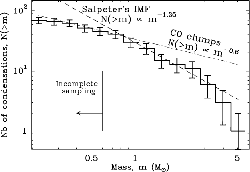| (1.12) |
| (1.12) |
| Paper | Region | Mass range | |
| Loren (1989) |
|
||
| Stutzki & Guesten (1990) | M17 SW |
|
|
| Lada et al (1991) | L1630 |
|
|
| Nozawa et al (1991) |
|
||
| Tatematsu et al. (1993) | Orion A |
|
|
| Dobashi et al (1996) | Cygnus |
|
|
| Onish et al (1996) | Taurus |
|
|
| Kramer et al.(1998) | L1457 etc |
|
|
| Heithausen et al (2000) | MCLD123.5+24.9,Polaris Flare |
|
|
| Onishi et al. (2002) | Taurus H |
|
 |